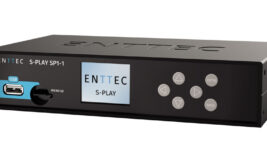WIRELESS
15 Nov 2024
Does WMAS Technology Still Require RF Management?

Subscribe to CX E-News
Our industry is on the precipice of change with the introduction of Wireless Multichannel Audio Systems – WMAS. But what is it and is it the answer to managing RF interference?
WMAS is a new method of efficiently using RF spectrum which is a diminishing but finite resource. Although it is wideband technology, it allows users to deploy many audio channels within a single TV channel.
Presently, only the two major manufacturers – Sennheiser and Shure – have announced that they have products supporting WMAS and as expected, there are some differences in their implementations of this new standard.
Does this mean we no longer need to consider wireless management at large events? Well, that depends. In a system where there is a single provider onsite and all devices are networked using Spectera or Axient Digital then probably not. Those systems can natively manage interference within the parameters the operator has programmed into them.
The complexity of RF Spectrum Management comes when there are multiple suppliers using lots of different systems that support differing technologies and they are not networked, so are not communicating with each other. It is in this sort of scenario that independent RF Spectrum Management will remain relevant.
The major manufacturers have both indicated that WMAS will not replace traditional narrow band wireless audio devices in the short term, however, we can expect that over the next few years this technology will trickle down from the high-end products in their ranges to lower end products just as we have seen throughout the evolution of digital audio. It is expected that there will be a mix of wideband and narrow band products in use together for quite some time.
Even as the number of wide band devices in use increases, competent RF Spectrum Managers who know the products in use and understand how all the devices can be used efficiently and effectively will be needed on large or complex events. This is particularly important in the shorter term when we can expect to see a mix of different technologies in use.
Sennheiser Spectera’s WMAS utilises one TV channel which is either 6MHz in the US or 8MHz in Europe. At the time of writing, it is unclear how units imported into Australia (with 7MHz channel spacing) will be handled. Shure’s Axient Digital PSM allows users to program four stereo channels in a 1MHz block.
Channel disparity aside, should a user turn up on site with multiple WMAS systems, there may not be enough “spare” spectrum for narrow band devices utilised by other event stakeholders. An RF Spectrum Manager can help with coordinating this with various tools at their disposal and their extensive knowledge.
Continued development of new technologies in this industry is essential as RF spectrum is a finite resource that is having more and more demand placed on it. RF Spectrum Management will not be replaced by the new technologies but will evolve to maximise their agility and continually push for more efficient use of spectrum.
Subscribe
Published monthly since 1991, our famous AV industry magazine is free for download or pay for print. Subscribers also receive CX News, our free weekly email with the latest industry news and jobs.






